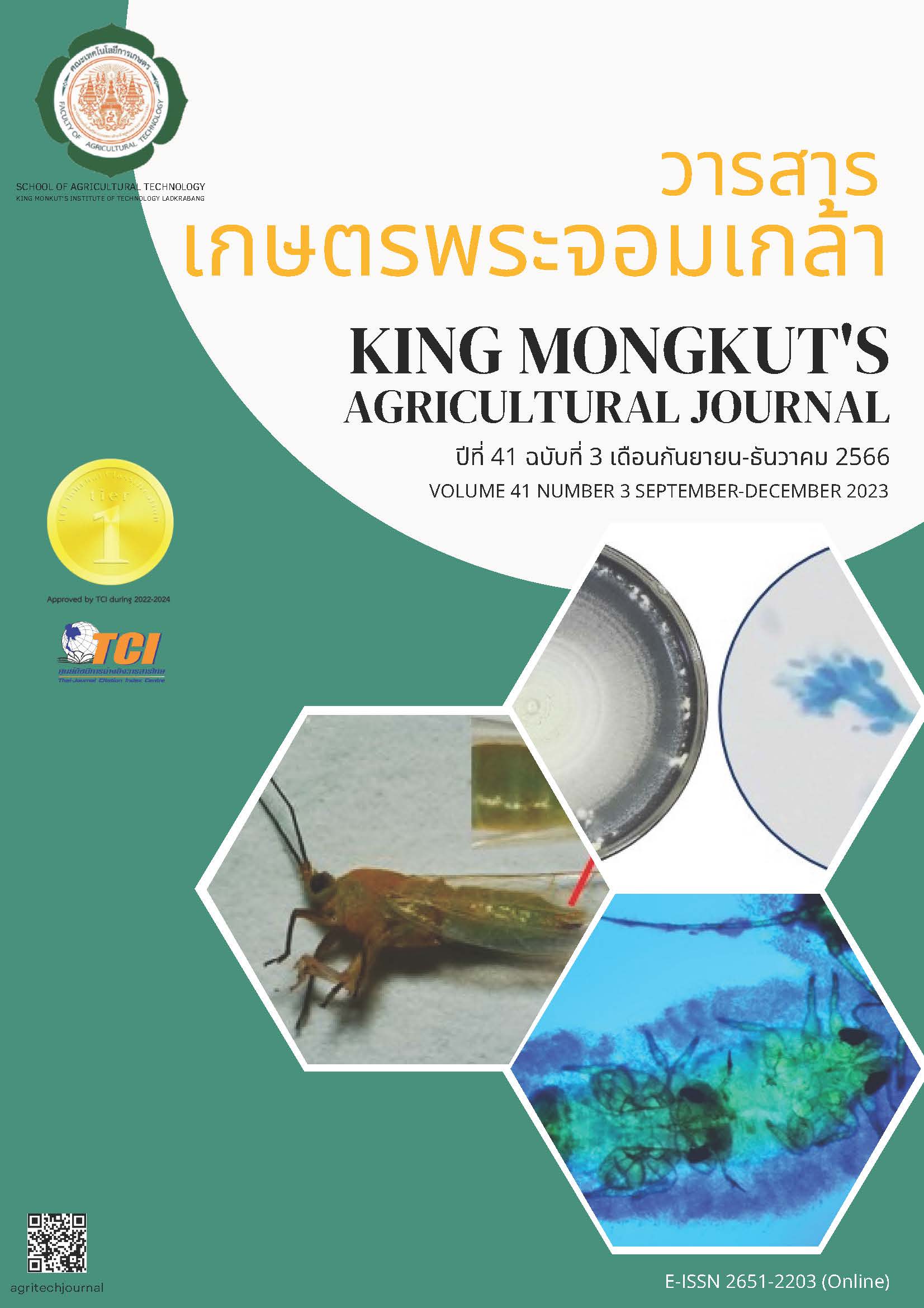การเปลี่ยนแปลงคุณภาพในระหว่างการเก็บรักษาของเมล็ดพันธุ์พริกหลังการไพร์มมิ่ง ด้วยความเร็วในการลดความชื้นต่างกัน
Main Article Content
บทคัดย่อ
ศึกษาการเปลี่ยนแปลงคุณภาพในระหว่างการเก็บรักษาเมล็ดพันธุ์พริกที่ผ่านการไพร์มมิ่งและลดความชื้นด้วยความเร็วต่างกัน นำเมล็ดพันธุ์พริกชี้ฟ้าพันธุ์แม่ปิง ที่มีความงอก 98% มาทำฮาโล-ไพร์มมิ่งในสารละลาย KNO3 2% นาน 3 วัน ก่อนนำไปลดความชื้น 2 วิธี คือ 1) แบบเร็ว (fast drying; FD) โดยบ่มในตู้ควบคุมความชื้นที่ 35% RH 3 วัน และ 2) แบบช้า (slow drying; SD) โดยบ่มในตู้ควบคุมความชื้นที่ 75% RH 2 วัน ตามด้วย 50% RH 2 วัน และ 35% RH อีก 3 วันตามลำดับจากนั้นนำเมล็ดพันธุ์ที่ไม่ผ่านการไพร์มิ่ง(กรรมวิธีควบคุม) และผ่านการไพร์มมิ่งแล้วลดความชื้นแบบ FD และ SD ไปเก็บรักษาที่อุณหภูมิต่ำ (5°C) นาน 12 เดือน และอุณหภูมิสูง (40°C) นาน 6 เดือน พบว่า ก่อนเก็บรักษา เมล็ดพันธุ์พริกที่ผ่านการไพร์มมิ่งมีเปอร์เซ็นต์ความงอกไม่แตกต่างทางสถิติจากกรรมวิธีควบคุม แต่การไพร์มิ่งและลดความชื้นแบบ SD ให้ความเร็วในการงอกมากกว่าแบบ FD และกรรมวิธีควบคุม และในระหว่างเก็บรักษาทั้งสองอุณหภูมิ พบว่า เมล็ดพันธุ์กรรมวิธีควบคุมมีความงอกสูงที่สุดทั้ง 2 สภาพอุณหภูมิตลอดอายุเก็บรักษา การไพร์มมิ่งเมล็ดพันธุ์พริกและลดความชื้นแบบ SD ทำให้เปอร์เซ็นต์ความงอก และกิจกรรมของเอนไซม์แคทตาเลสในเมล็ดพันธุ์พริกลดลง มีการรั่วไหลของเยื่อหุ้มเซลล์และการสะสมไฮโดรเจนเปอร์ออกไซด์เพิ่มขึ้นมากกว่าการลดความชื้นแบบ FD และกรรมวิธีควบคุมอย่างมีนัยสำคัญทางสถิติ โดยความแตกต่างทางสถิติดังกล่าวเกิดขึ้นเมื่อเก็บรักษาเมล็ดพันธุ์ที่อุณหภูมิสูงได้เร็วกว่าการเก็บรักษาที่อุณหภูมิต่ำ
Article Details

อนุญาตภายใต้เงื่อนไข Creative Commons Attribution-NonCommercial-NoDerivatives 4.0 International License.
วารสารเกษตรพระจอมเกล้า
เอกสารอ้างอิง
Afzal, I., Hussain, B., Basra, S. M. A. & Ullah, S. H. (2011). Halopriming triggers higher germination potential and early seedling growth of tomato. Journal of Agriculture & Social Science. 7, 105-108.
Amooaghaie, R., Nikzad, K. & Shareghi, B. (2010). The effect of priming on emergence and biochemical changes of tomato seeds under suboptimal temperatures. Seed Science and Technology. 38 (2), 508-512.
Bailly, C., El-Maarouf-Bouteau, H. & Corbineau, F. (2008). From intracellular signaling networks to cell death: the dual role of reactive oxygen species in seed physiology. C.R. Biologies. 311, 806-814.
Bewley J. D., Bradford, K., Hilhorst, H. & Nonogaki, H. (2013). Seeds: physiology of development, germination and dormancy. New York: Springer.
Bryant, G., Koste, K. L. & Wolfe, J. (2001). Membrane behaviour in seed and other systems at low water content: the various effects of solutes. Seed Science Research. 11, 17-25.
Buitink, J., Benoit, L. V., Satour, P. & Leprince, O. (2003). The re-establishment of desiccation tolerance in germinated radicles of Medicago truncatula gaertn seeds. Seed Science Research. 13, 273-286.
Bruggink G. T., Ooms, J. J. & Toorn, P. van der. (1999). Induction of longevity in primed seeds. Seed Science Research. 9, 49-53.
Chen, K. & Arora, R. (2013). Priming memory invokes seed stress-tolerance. Environmental and Experimental Botany. 94, 33-45.
Copeland, L. O. & McDonald, M. B. (2001). Principle of Seed Science and Technology 4th edition. Norwell, Massachusetts: Kluwer Academic Publishers.
Dekkers, B. J. W., Costa, M. C. D., Maia, J., Bentsink, L., Ligterink, W. & Hikhorst, H. W. M. (2015). Acquisition and loss of desiccation tolerance in seeds: from experimental model to biological relevance. Planta. 241, 563-577.
Demir, I. (2003). Effect of controlled hydration treatment on quality of aubergine seeds following storage. Phyton. 43, 307-317.
Girolamo, G. D. & Barbanti, L. (2012). Treatment conditions and biochemical process influencing seed priming effectiveness. Italian Journal of Agronomy. 7(2), 178-188.
Goel, A., Goel, A. K. & Sheoran, I. S. (2003). Changes in oxidative stress enzymes during artificial ageing in cotton (Gossypium hirsutum L.) seeds. Journal of Plant Physiology. 160, 1093-1100.
Gomes, D. P., Silva, A. F., Dias, D. C. F. S., Alvarenga, E. M., Silva, L. J. & Panozzo, L. E. (2012). Priming and drying on the physiological quality of eggplant seeds. Horticultural Brasileira. 30, 484-488.
Gurusinghe, S. & Bradford, K. J. (2001). Galactosyl-sucrose oligosaccharides and potential longevity of primed seeds. Seed Science Research. 11, 121-133.
Heydecker, W. & Coolbear, P. (1977). Seed treatments for improve performance-survey and attempted prognosis. Seed Science and Technology. 5, 353-425.
Horticulture Research Institute. (2020). Hot-chili production situation. Retrieved from: https://www.doa.go.th/hort/wp-content/uploads/2020/10/hot-chili production situation. October 2020.pdf
International Seed Testing Association (ISTA). (2014). Seed Vigour Testing: International Rules for Seed Testing. Zurich: International Seed Testing Association.
International Seed Testing Association (ISTA). (2018). ISTA Handbook on Seedling Evaluation. 4th ed. Zurich: International Seed Testing Association.
Joosen, R. V. L., Kodde, J., Willems, L. A. J., Ligterink, W., Van der Plas, L. H. W. & Hilhorst, H. W. M. (2010). Germinator: a software package for high-throughput scoring and curve fitting of arabidopsis seed germination. The Plant Journal. 62(1), 148-159.
Lin, R. H., Chen, K. Y., Chen, C. L., Chen, J. J. & Sung, J. M. (2005). Slow post-hydration drying improves initial quality but reduces longevity of primed bitter gourd seed. Scientia Horticulturae. 106, 114-124.
Mal, D., Verma, J., Levan, A., Reddy, M. R., Avinash, A. V. & Velga, P. K. (2019). Seed priming in vegetable crops: a review. International Journal of Current Microbiology and Applied Sciences. 8(6), 868-874.
Powell, A. A., Yule, L. J., Jung, H., Groot, S., Bino, R. J. & Pritchard, H. W. (2000). The influence of aerated hydration seed treatment on seed longevity as assessed by the viability equations. Journal of Experimental Botany. 51, 2031-2043.
Pukacka, S. & Ratajczak, E. (2005). Production and scavenging of reactive oxygen species in Fagus sylvatica seeds during storage at varied temperature and humidity. Journal of Plant Physiology. 162(8), 873-85.
Schwember, A. R. & Bradford, K. J. (2005). Drying rates following priming affect temperature sensitivity of germination and longevity of lettuce seeds. HortScience. 40(3), 778-781.
Velikova, V., Yordanov, I. & Edreva, A. (2000). Oxidative stress and some antioxidant systems in acid rain-treated bean plants: protective role of exogenous polyamines. Plant Science. 151(1), 59-66.
Welbaum, G., Shen, Z., Oluoch, M. O. & Jett, L. W. (1998). The evolution and effects of priming vegetable seeds. Seed Technology. 20(2), 209-237.


